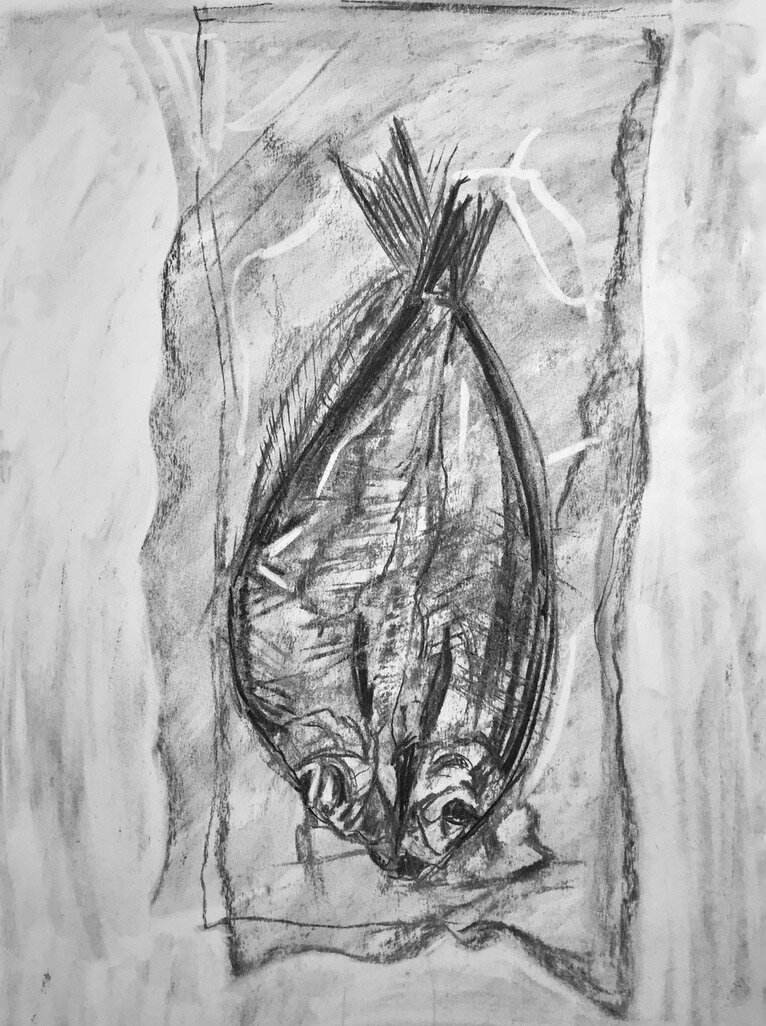The idea for this piece came from a pair Craster kippers I’d bought in a local farm shop. We were going to eat them for lunch but the colours and patterns contrasting with the plastic bag made me think they would make an interesting addition to my paintings looking at food in containers.
continuous line drawing
charcoal sketch
There is something I find slightly macabre about the hollow eye sockets of kippers. They remind me of peat bog bodies or mummies except by being brined, smoked and wrapped in plastic they are preserved for eating.
As well as the colours and textures I found the bag interesting as it created strong bright highlights and soft defused shadows.
To begin with I tried a couple of quick drawing exercises to get my eye in and to see if the composition worked. The kippers were stuck to a board with blue tack and I played around with the lighting so the bag cast a shadow.
Details of fish scales in pencil
For this subject I used looser scratchy marks to describe the overall effect of the kippers surface and used directional marks to create the gentle plump edges of their bellies. By working into the pencil with a rubber and then redrawing into these areas I found it added to the battered weathered feel of their skin.
Etching of Kippers by Prunella Clough 1954. Published in the Tate Gallery 1982-84: Illustrated Catalogue of Acquisitions, London 1986
One of my influences fo this piece was an etching by British artist Prunella Clough. I especially like the simple composition and the way she describes the skin with mark making and the textural effects from the printmaking technique.
I once had an art tutor who talked about capturing the character or essence of a subject in an illustration. We were drawing from memory (something I find extremely difficult) and he was explaining that It isn’t always about drawing every detail. I think about this a lot when I draw or paint and for me Clough’s etching is a good example, as we recognise the shape of the fish but there is that added extra something that she has captured by leaving out the detail.
pencil drawing of Craster kippers
I found a strange beauty in the contrast of the jewel like fish encased in the delicate tones of the plastic. Some of my other paintings explore the distortion of shapes and colour through glass or plastic but there is always part of the subject that can be seen in its natural state. The kippers were very different to draw as they are preserved and completely sealed with a few crinkles in the plastic where fluid has collected.
Blotted line technique - printing with drawing ink
Using my original drawing I select the line I want to print and draw them onto tracing paper. This sheet is hinged to a stretched piece of watercolour paper and using a dip pen and Indian ink I transfer the image.
masking fluid and first pale washes of watercolour
Initially I approached this painting by using broken areas of tone as I thought it would describe the battered metallic colours I could see.
It didn’t work as I gradually realised that the colours softly melted together and so I printed over the top of the paint using the directional and textural marks from my drawing.
Tracing areas of tone from the original drawing to transfer onto the watercolour painting.
Watercolour painting of kippers in progress.
Adding darker tones to the edges.
Kippers for Tea - blotted line and watercolour painting by Lucy Clayton
Coming up with titles for paintings is normally quite hard and I generally like to keep them simple but with this piece it had to be named after a funny song that was on the radio a lot when I was young and my dad would sing along with it when cooking Kippers.
If you would like to listen visit https://www.youtube.com/watch?v=wlngeFB7p88
Giclee prints of Kippers for Tea are available from the shop page.














